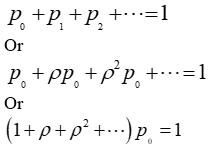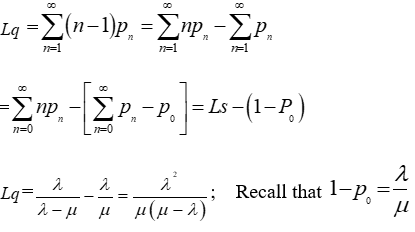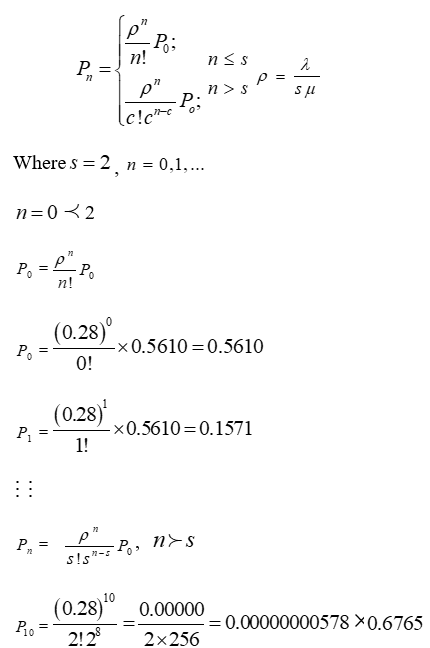Queuning Modelling on the Performance of Automated Teller Machine (ATM) in Uba Lokoja, Kogi State.
- U. M. Sani
- S.M. Michael
- V.O, Olokojo
- Ahiaba Mathias
- 342-355
- May 20, 2024
- Education
Queuning Modelling on The Performance of Automated Teller Machine (ATM) In Uba Lokoja, Kogi State.
1U. M. Sani*, 2S.M. Michael, 2V.O, Olokojo, 3Ahiaba Mathias
1,2.3Department of Statistics, School of Applied Sciences, Kogi State Polytechnic Lokoja. P.M.B. 1101 Lokoja, Kogi State.
*Corresponding author’s
DOI: https://doi.org/10.51584/IJRIAS.2024.904024
Received: 24 December 2023; Accepted: 17 January 2024; Published: 18 May 2024
ABSTRACT
This paper work investigates the performance of United Bank for Africa (UBA) Automated Teller Machine (ATMs) using M/M/S queue model. The data collected for this work was for a period of five working days (Monday-Friday), 10 hours was considered from (8.00am-5.00pm). The result showed that the average time a customer spent waiting in the system is 1.13 hours which is equivalent to 6.41 minutes and the utilization of factor is 0.28, It was observed that the machines have busy time 0f 2.80 hours while the idle time of the machines is 7.20 hours out of the 10 hours considered in each day and the probability of no. customer in the queue is 0.56, though there are four ATM machines in the location but 2 were considered in this paper work. The result indicates that the service delivery by the machine is efficient and fast, and addition of ATM is not required in the location. However, we recommend that adequate maintenance of the machine should be routinely carried out to ensure efficient and good service delivery.
Key Words: Arrival rate, Service rate, Queuing system, Reneging, Balking, Jockeying
INTRODUCTION
The economic sector in Nigeria has witness large reform in recent times, with effort to minimizeprofit, reduce cost and satisfy customers optimally in most generally and acceptable international standard way. Despite all those efforts one phenomenon remains unavoidable: queue. It is a normal custom to see very long waiting lines of customers to be severed either at the Automated Teller Machine (ATM) or within the banking hall.
Taha (2008) defines queue as simply a waiting line, (while Hiray, 2008) put it in a similar way as a waiting lineby to two important elements: the population sources of customer from which they can be draw and the service system.
Automated Teller Machine (ATM) is one of the several electronic banking channels used in the banking industry. According to Isah A. (2019), Automated Teller Machines (ATMs) are among the most important service facilities in the banking industry. Despite being in the technology era; line are experienced within Banks and ATMs in developing nations. ATM are adopted so as to reduce waiting time, to offers considerable ease to both the banks and their customers; as it enables customers to make financial transactions at more convenient times and locations, during and after banking hours.
However, in situations where queue arises in a system, it is appropriate to attempt to minimize the length of the queue rather than to eliminate it completely; complete elimination may be infeasible Therefore, a systematic study of waiting line would assist the managements of the Banks in making certain decisions in an effort to minimize the time a customer spent in a service facilities.
This paper seeks to illustrate the usefulness of applying queuing theory in a real cases situation.
Aim and Objectives:
The aim of this paper work is to investigate the performance of ATMS queuing system at United Bank for Africa (UBA) Lokoja.
The objectives of this study are:
i. To determine the Arrival rate =λand Service rate =μ
ii. To determine average system utilization =ρ and prob. of no. customer in the queue =p0
iii. To determine average number of customers in the queue (Lq) and in the system (Ls)
iv. To determine average waiting time for a customer in the queue (Wq) and in system (Ws)
v. To determine the probability of number of customers in the system.
LITERATURE REVIEWS
Olaniyi (2004) examined the relationship between arrival rates of customers and bank’s service rates in Ile-Ife. The study revealed that there is a positive correlation between arrival rates of customers and bank’s service rates. The study concluded that the potential utilization of the banks service facility was 3.18% efficient and idle 68.2% of the time. However, Ashley (2006) asserted that even if service system can provide service at a faster rate than customers’ arrival rate, waiting lines can still occur if the arrival and service processes are random.
Christopher Osita Achebe and Desmond (2017) examine a frame for evaluating the performance of automated teller machine in banking industries: A queuing model-cum-TOPSIS approach and it was observed that an empirical study on performance ranking of ATM used by banks was presented in this paper. This was achieved using an integrated queuing-TOPSIS framework. The framework considered ATM utilization, percentage of customers’ loss, total cost of service and expected length of customers in a queuing system, as well as the expected waiting time of customers in a queuing system and expected waiting time of customers in a queue as performance indices. The results obtained revealed that Bank A was the highest ranked bank, while Bank D was the least ranked bank. The results obtained showed that two banks had ATM utilization values of above 50%, while the other two banks had ATM utilization values of less than 50%. The average ATM usage in the study area was about 48.02%. Based on these results obtained, banks in the study areas should install one or two ATM at each location to improve on the utilization of ATM, a study using benefits-cost analysis could be considered as a further study.
Suhel A. (2018) worked on queuing theory in selected banks in Bangladesh to find out the normal amount of time a customer needs to spend in a queue at the bank’s ATM and also the actual time needed by the bank administration staff for providing service.
Alex M and Kabamba, (2019) make research on modeling and analysis of queuing systems in banks using commercial banks in Congo. They examined the application of queue theory in the banking system in Democratic Republic of Congo, with particular reference to BCDC (Banque Commercial Congo) Mbujimayi. The queuing characteristics of the bank were analyzed using a Multi-Server Queuing Model. The obvious implication of customers waiting in long and winding queues could result to prolonged discomfort and economic cost to them, however increasing the service rate will require additional number of tellers which implies extra cost to management. Data for this study was collected at BCDC bank for one week through observations and was formulated as multi-server single line queuing model. The data was analyzed using TORA optimization Software as recommended software for operational research. The performance measures of different queuing systems were evaluated and analyzed. The results of the analysis showed using a six-teller system was better than a five in terms of average waiting time.
L.K. Bhavani and G.Jayalalit (2021) work on applying Queuing Theory to Enhance the Service Provided by A Restaurant Annals of R.S.C.B.
METHODOLOGY
The method of analysis for this study is the multi-server queuing modeling system which follows (M/M/S): (∞/FCFS) specification. In the case, the performance measure analysis including, the arrival time, waiting time service time, priority level, average customers and the number of servers available were computed using the appropriate tools
Tab1e 3.1.1: Some of the terms present in the model
| Terms | Interpretation |
| λ | The mean customer arriving rate per minute |
| μ | The mean customer service rate per minute |
| ρ | The utilization factors |
| L | Average length of non-empty queue |
| Lq | Average number of customers waiting in the queue |
| Ls | Average number of customers in the system |
| Wq | Average waiting time that a customer spends in the system |
| Ws | Average waiting time that a customer spends in the system |
| N | Number of total customer in the system |
Performance Measure of Single Server Queue Model M/M/1
The single server model is constructed so that queue lengths and waiting line can be predicted. To determine the performance measures, the probability having n number of customers in the queue system will be find first
The probability of having one customer in the system is give: P1=ρP0
Similarly
It is knowing that the sum of the sum of the probabilities is 1, that is
Where (1+ρ+ρ2+⋯)is an infinite series?
Sum of infinite series can be written as (1/1−ρ)
Where
p0=1−ρ is the probability of no customer in the system.
(a) The Average number of customers in the system (customers in the line plus customer being served)
(b) Average number of customers waiting in the queue (i.e queue length)
(c) Average waiting time for a customer in the queue
(d) Average waiting time for a customer in the system (waiting and service)
Ws = Expected waiting time in the queue + Expected service time
(e) The variance of the queue length
(f) Probability that the queue is non-empty
(g) Probability that the number of customers, n in the system exceeds a given number k
(h) Average length of non-empty queue
Assumption of Queuing Model with Single Queue and Multiple servers (M/M/S)
For this kind of model, the following assumptions are made:
(1) The arrivals follow a Poisson probability distribution at an average rate of λ customers per unit of time.
(2) There must be only one channel which arrivals enter one at time. i.e. one queue on server
(3) There is an infinite calling population from which arrivals originate
(4) Arrival are served of a first come first-served basis
(5) There is balking and reneging of customers
Performance Measures for Multiple Server Queue Model M/M/S
(1) Utilization of factor (the Average fraction of time servers are busy)
ρ = λ/sμ
(2) Average number of customers waiting in the queue
(3) Average number of customers in the system
Ls =Lq + λ/μ
(4) Average waiting time of a customer in the queue
RESULT OF ANALYSIS
Table 4.0.1: The summary of the data (Server 1)
| DAYS | INTER-ARRIVAL TIME | NUMBER OF CUSTOMERS | SERVICE TIME FOR SEVER 1 |
| MONDAY | 289 | 150 | 383.81 |
| TUESDAY | 386 | 50 | 325.23 |
| WEDNESDAY | 276 | 146 | 323.38 |
| THURSDAY | 386 | 178 | 301.01 |
| FRIDAY | 340 | 115 | 356.53 |
Source: United Bank for Africa Lokoja, Kogi State
Table 4.0.2: The summary of the data (Server 2 )
| DAYS | INTER-ARRIVAL TIME | NUMBER OF CUSTOMERS | SERVICE TIME FOR SERVER 2 |
| MONDAY | 300 | 199 | 367.48 |
| TUESDAY | 201 | 18 | 320.07 |
| WEDNESDAY | 326 | 147 | 304.95 |
| THURSDAY | 200 | 133 | 308.28 |
| FRIDAY | 252 | 210 | 345.00 |
Source: United Bank for Africa Lokoja, Kogi State
Table 4.0.3: The summary of the data for both server 1 and 2
| DAYS | INTER-ARRIVAL TIME | NUMBER OF CUSTOMERS | SERVICE TIME FOR SEVER 1 | SERVICE TIME FOR SERVER 2 | AVERAGE SERVICE TIME |
| MONDAY | 589 | 349 | 383.81 | 367.48 | 375.65 |
| TUESDAY | 587 | 320 | 325.23 | 320.07 | 322.65 |
| WEDNESDAY | 581 | 311 | 323.38 | 304.95 | 314.17 |
| THURSDAY | 602 | 293 | 301.01 | 308.28 | 304.65 |
| FRIDAY | 592 | 325 | 356.53 | 345.00 | 350.77 |
Source: United Bank for Africa Lokoja, Kogi State
Table 4.1: The analysis of the data
| DAYS | INTER-ARRIVAL | SERVICE TIME | NUMBER OF CUSTOMER | |
| MONDAY
|
TOTAL AVERAGE | 589
589÷349=1.687 |
375.65
375.65÷349=1.076 |
349
|
| TUESDAY | TOTAL AVERAGE | 587
587÷320=1.834 |
322.65
322.65÷320=1.008 |
320
|
| WEDNESDAY | TOTAL AVERAGE | 581
581÷311=1.834 |
314.17
314.17÷311=1.010 |
311
|
| THURSDAY | TOTAL AVERAGE | 602
602÷293=2.055 |
304.65
304.65÷293=1.040 |
293
|
| FRIDAY | TOTAL AVERAGE | 592
592÷325=1.822 |
350.77
350.77÷325=1.079 |
325 |
| SUM TOTAL
AVERAGE |
9.266
9.266÷5=1.8532 |
5.213
5.213÷5=1.0426 |
Mean arrival time = sum total inter arrival time /number of days = 9.266/5 = 1.8532
Mean service time = sum total of average service/ time number of days = 5.213/5 = 1.0426
(1) (a)Arrival rate λ = 1/1.8532 = 0.54
(2)Service rate μ = 1/1.043 = 0.96
(3)Average system utilization
Where, s=2
(4) (a)To determine the busy time β = Banking working hours multiply by the utilization factor i.e
β = Banking working hours × ρ = λ/sμ
β = 10×(0.28)
β = 2.8 Hours
(b)To determine the idle time
α = The difference between the banking working hours of the machine and the busy time i.e
α = Banking working time of the machine− β
α = 10 – 2.8 = 7.2 Hours
(5) Probability of no customer in the queue
(7) Average number of customers in the system (Ls)
Ls = Lq+λ/μ
Ls = 0.0483+0.54/0.96
Ls = 0.0483+0.5625=0.6105 Customers per Hour =0.6105×60=36.63 Customers per Minutes
(8) Average waiting time for a customer in the queue (Wq)
(9) Average waiting time for a customer in the system (Ws)
(10) Probability of n Customers in the System (Pn)
Table 4.1.1: Probability of n Customers in the System and their Cumulative
| N | PROBABILITY | CUMULATIVE |
| 0 | 0.5610 | 0.5610 |
| 1 | 0.1571 | 0.7181 |
| 2 | 0.0392 | 0.7573 |
| 3 | 0.00549 | 0.76279 |
| 4 | 0.000769 | 0.763559 |
| 5 | 0.000108 | 0.763667 |
| 6 | 0.0000151 | 0.7636821 |
| 7 | 0.00000211 | 0.76368421 |
| 8 | 0.000000295 | 0.763684505 |
| 9 | 0.0000000414 | 0.7636845464 |
| 10 | 0.00000000578 | 0.76368455218 |
CONCLUSION
The performance of United bank for Africa (UBA) Automated Teller Machine ATMS has been investigated using M/M/S. It was observed that the arrival rate (λ) is 0.54, service rate (μ) is 0.96, the probability of no customer in the queue is 0.56, busy time is 2.80 while the idle time is 7.20 hours out the 10 hours studied, The average time a customer spent in the system is 1.13 hours which is equivalent to 6.41 minutes and Utilization of factor is 0.28, this indicate that the service delivery by the machine is efficient and fast. The result of this research can contribute to the betterment of United bank for Africa (UBA) Automated Teller Machine ATMSin terms of its way of dealing with customers.
Based on the analysis, the result obtained from this research indicate that addition of ATM is not necessary in the location, though there are 4 ATM machines in the location but 2 where considered in this research work, however we recommend that adequate maintenance of the machine should be routinely carried out to ensure the effective and efficient service delivery by the machines.
REFERENCES
- Ajayi F. O &Olayemi M.S. (2018), Operational Research for Mathematical Science.Agunbay publisher, Ibadan
- Alex m. and Kabamba (2019), Multi-Channel, Multi-Servers on the performance of queuing model for six- teller system.
- Akinnuli and Olugbade. (2018) contextual investigation on 7 specialists multiple channel
- Aliyu U. (2016).Introduction to Bivariate and Multivariate Statistical Analysis. Millennium printing and publishing company limited, Kaduna. Page 462-477
- Anders0n, (2007) A note on managing waiting lines. UT McCombs School of Business,.
- Anokey et al. (2013) Multi-Channel, Multi-Servers motor spirit filling station Ghana
- Ashley. (2006), – Channel, Multi-Servers on the performance of waiting line
- Bakare et al. (2014) Multi-Channel, Multi-Servers on the performance of traffic intensity
- Christopher OsitaAcheba and Desmond. (2017), multiple channel on Automated teller machine in banking industries Bangladesh
- Chukka et al. (2014) queuing modeling of the performance on traffic congestion in Ghana
- Isah A. (2019) Queuing model on the performance of Automated teller machine ATM (case study of First City Bank Minna Niger State)
- Hiray and Taha. (2008), Waiting lines and Queuing System, Article of Business Management, Sharma, operations Research: Theory and Application, 3rd Ed. (Macmillan ltd., India 2007)
- Olaniyi T.A (2004), “An Appraisal of Cost of Queuing in Nigerian Banking Sector: A Case Study of First Bank of Nigeria Plc, Ilorin”. Journal of Business & Social Sciences.Vol. .9, Nos, 1&2, pages 139-145. 2004. Optimality of a static priority policy in heavy traffic. Operations Research, 58(1):94–110,2010. Optimality of a static priority policy in heavy traffic. Operations Research, 58(1):94–110,
- Scandit (2013), Application of database on point of sale (POS) of commercial banking in Nigerian.
- Suhel A. et al (2018), Queuing model on the performance of automated teller machine in Bangladesh.
- L.K. Bhavani and G. Jayalalitha: Applying Queuing Theory to Enhance the Service Provided by A Restaurant Annals of R.S.C.B., ISSN:1583-6258, Vol. 25, Issue 6, 2021, Pages. 4479 – 4484


















